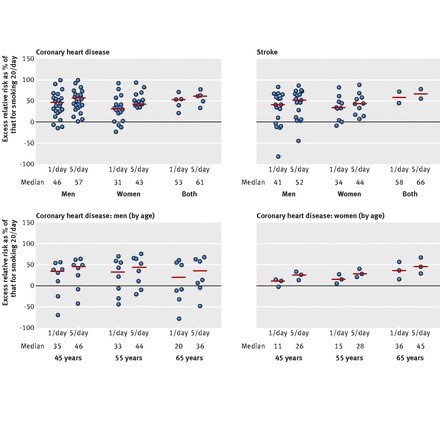The BMJ ( IF 105.7 ) Pub Date : 2018-01-24 , DOI: 10.1136/bmj.j5855 Allan Hackshaw , Joan K Morris , Sadie Boniface , Jin-Ling Tang , Dušan Milenković

|
Objective To use the relation between cigarette consumption and cardiovascular disease to quantify the risk of coronary heart disease and stroke for light smoking (one to five cigarettes/day).
Design Systematic review and meta-analysis.
Data sources Medline 1946 to May 2015, with manual searches of references.
Eligibility criteria for selecting studies Prospective cohort studies with at least 50 events, reporting hazard ratios or relative risks (both hereafter referred to as relative risk) compared with never smokers or age specific incidence in relation to risk of coronary heart disease or stroke.
Data extraction/synthesis MOOSE guidelines were followed. For each study, the relative risk was estimated for smoking one, five, or 20 cigarettes per day by using regression modelling between risk and cigarette consumption. Relative risks were adjusted for at least age and often additional confounders. The main measure was the excess relative risk for smoking one cigarette per day (RR1_per_day−1) expressed as a proportion of that for smoking 20 cigarettes per day (RR20_per_day−1), expected to be about 5% assuming a linear relation between risk and consumption (as seen with lung cancer). The relative risks for one, five, and 20 cigarettes per day were also pooled across all studies in a random effects meta-analysis. Separate analyses were done for each combination of sex and disorder.
Results The meta-analysis included 55 publications containing 141 cohort studies. Among men, the pooled relative risk for coronary heart disease was 1.48 for smoking one cigarette per day and 2.04 for 20 cigarettes per day, using all studies, but 1.74 and 2.27 among studies in which the relative risk had been adjusted for multiple confounders. Among women, the pooled relative risks were 1.57 and 2.84 for one and 20 cigarettes per day (or 2.19 and 3.95 using relative risks adjusted for multiple factors). Men who smoked one cigarette per day had 46% of the excess relative risk for smoking 20 cigarettes per day (53% using relative risks adjusted for multiple factors), and women had 31% of the excess risk (38% using relative risks adjusted for multiple factors). For stroke, the pooled relative risks for men were 1.25 and 1.64 for smoking one or 20 cigarettes per day (1.30 and 1.56 using relative risks adjusted for multiple factors). In women, the pooled relative risks were 1.31 and 2.16 for smoking one or 20 cigarettes per day (1.46 and 2.42 using relative risks adjusted for multiple factors). The excess risk for stroke associated with one cigarette per day (in relation to 20 cigarettes per day) was 41% for men and 34% for women (or 64% and 36% using relative risks adjusted for multiple factors). Relative risks were generally higher among women than men.
Conclusions Smoking only about one cigarette per day carries a risk of developing coronary heart disease and stroke much greater than expected: around half that for people who smoke 20 per day. No safe level of smoking exists for cardiovascular disease. Smokers should aim to quit instead of cutting down to significantly reduce their risk of these two common major disorders.
中文翻译:

低烟消费量和冠心病和中风的风险:55个研究报告中141个队列研究的荟萃分析
目的利用卷烟消费量与心血管疾病之间的关系来量化轻度吸烟(每天吸烟1至5支)患冠心病和中风的风险。
设计系统的审查和荟萃分析。
资料来源: Medline 1946年至2015年5月,其中包括对参考文献的手动搜索。
选择研究的资格标准至少进行50次事件的前瞻性队列研究,报告与从未吸烟者或与冠心病或中风风险相关的特定年龄发生率的危险比或相对风险(以下均称为相对风险)。
数据提取/综合遵循MOOSE准则。对于每项研究,通过使用风险和卷烟消费之间的回归模型,估计每天吸烟一,五或二十支烟的相对风险。至少针对年龄调整了相对风险,通常还会增加其他混杂因素。主要测量指标是每天吸烟1支(RR 1_per_day -1)的相对相对风险,以每天吸烟20支香烟(RR 20_per_day -1)的相对风险的比例表示,假设两者之间存在线性关系,则预期约为5%。风险和消费(如肺癌)。在一项随机荟萃分析中,所有研究还汇总了每天一支,五支和二十支香烟的相对风险。对性别和障碍的每种组合分别进行了分析。
结果荟萃分析包括55篇出版物,其中包含141个队列研究。在所有研究中,男性的冠心病合并相对危险度为每天抽烟1.48,每天抽20支香烟2.04,但是在针对多个混杂因素进行调整的研究中,冠心病的相对危险度为1.74和2.27。在女性中,每天一支和20支卷烟的合并相对风险分别为1.57和2.84(或使用针对多种因素进行调整的相对风险,分别为2.19和3.95)。每天吸烟一根烟的男性有46%的每日相对危险度,每天吸烟20支(53%,使用针对多种因素调整后的相对危险度),而女性则为31%,在38%的情况下,使用了针对以下因素进行调整的相对风险多个因素)。对于中风,男性的相对危险度合计为1.25和1。每天吸烟1或20支香烟的标准为64(使用多种因素调整后的相对风险,分别为1.30和1.56)。在女性中,每天吸烟一根或20支卷烟的合并相对风险分别为1.31和2.16(使用针对多种因素进行调整的相对风险,分别为1.46和2.42)。每天一支香烟(相对于每天20支香烟)引起的中风的额外风险男性为41%,女性为34%(或使用针对多种因素进行调整的相对风险,分别为64%和36%)。女性的相对风险通常高于男性。每天一支香烟(相对于每天20支香烟)引起的中风的额外风险男性为41%,女性为34%(或使用针对多种因素进行调整的相对风险,分别为64%和36%)。女性的相对风险通常高于男性。每天一支香烟(相对于每天20支香烟)引起的中风的额外风险男性为41%,女性为34%(或使用针对多种因素进行调整的相对风险,分别为64%和36%)。女性的相对风险通常高于男性。
结论每天仅吸烟约有一支烟,患冠心病和中风的风险大大超过了预期:每天吸烟约20人的风险约为一半。对于心血管疾病,没有安全的吸烟水平。吸烟者应以戒烟而不是减少吸烟为目标,以显着降低其罹患这两种常见主要疾病的风险。

























 京公网安备 11010802027423号
京公网安备 11010802027423号